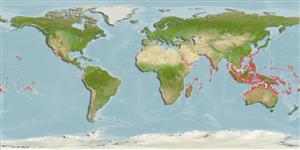Common names from other countries
>
Ovalentaria/misc (Various families in series Ovalentaria) >
Plesiopidae (Roundheads) > Plesiopinae
Etymology: Plesiops: Greek, plesios = near + Greek, ops = appearance (Ref. 45335); coeruleolineatus: Species name refers to the blue lines present in the dorsal and anal fins..
More on author: Rüppell.
Environment: milieu / climate zone / depth range / distribution range
Ecología
marino asociado a arrecife; rango de profundidad 1 - 23 m (Ref. 9710), usually 3 - 23 m (Ref. 27115). Tropical; 23°C - 27°C (Ref. 130632); 30°N - 30°S
Indo-Pacific: Red Sea and East Africa to Japan and Oceania.
Tamaño / Peso / Age
Maturity: Lm ? range ? - ? cm
Max length : 10.0 cm TL macho / no sexado; (Ref. 30874)
Espinas dorsales (total) : 10 - 12; Radios blandos dorsales (total) : 6 - 8; Espinas anales: 3; Radios blandos anales: 8. Color variable; body generally black or brown; 2 dark stripes behind eye; dorsal spines orange distally; bluish stripe along basal part of dorsal fin (Ref. 5473).
Adults are found under stone or corals in flood basins and lagoons (Ref. 9137). They are common but very secretive and usually found when turning rubble pieces in pools (Ref. 48635). They venture out in the open at night to feed on small crustaceans, fishes and gastropods (Ref. 37816). Eggs are guarded by the male parent (Ref. 205). Minimum depth reported from Ref. 30874.
Life cycle and mating behavior
Maturities | Reproducción | Spawnings | Egg(s) | Fecundities | Larva
Eggs are guarded by the male parent (Ref. 205).
Mooi, R.D., 1995. Revision, phylogeny, and discussion of biology and biogeography of the fish genus Plesiops (Perciformes: Plesiopsidae). Life Sci. Contrib. No. 159, 108 p. (Ref. 27772)
IUCN Red List Status (Ref. 130435)
Warning: mysqli::__construct(): (HY000/1040): Too many connections in /var/www/html/includes/func_getlabel.php on line 46
Can't connect to MySQL database (fbapp). Errorcode: Too many connections
